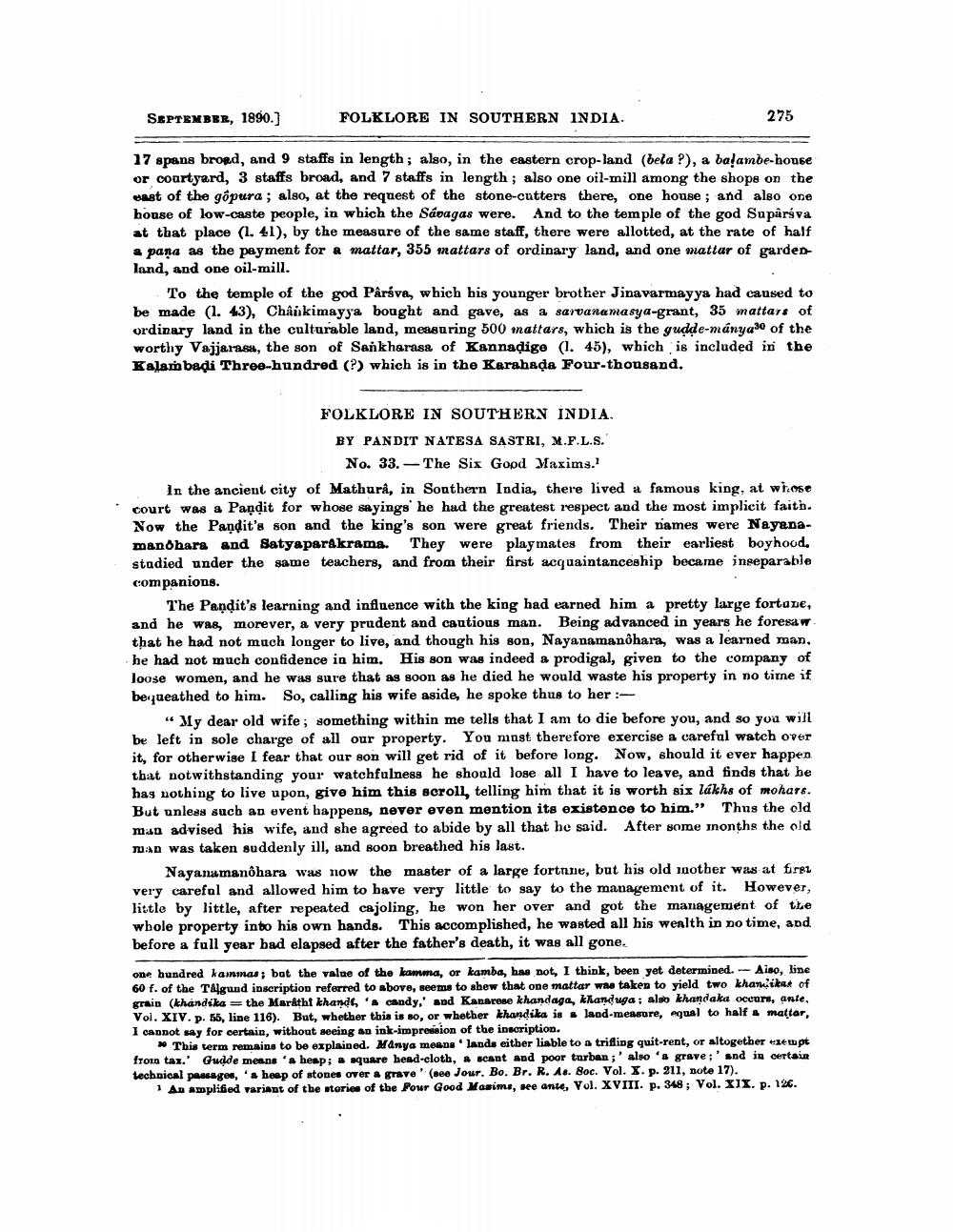________________
SEPTEMBER, 1890.)
FOLKLORE IN SOUTHERN INDIA.
275
17 spans brord, and 9 staffs in length; also, in the eastern crop-land (bela ?), a balambe-house or courtyard, 3 staffs broad, and 7 staffs in length ; also one oil-mill among the shops on the vast of the gópura; also, at the request of the stone-cutters there, one house; and also one house of low-caste people, in which the Savagas were. And to the temple of the god Saparáva at that place (1. 41), by the measure of the same staff, there were allotted, at the rate of half a pana as the payment for a mattar, 355 mattars of ordinary land, and one mattar of garden land, and one oil-mill.
To the temple of the god Paráva, which his younger brother Jinavarmayya had caused to be made (1. 43), Chaukimayya bought and gave, as a sardanamasya-grant, 35 mattars of ordinary land in the culturable land, measuring 500 mattars, which is the gudde-mányaso of the worthy Vajjarasa, the son of Sankharasa of Kannadige (1. 45), which is included in the Kalam badi Three-hundred (?) which is in the Karahada Four-thousand.
FOLKLORE IN SOUTHERN INDIA. BY PANDIT NATESA SASTRI, X.F.L.S.
No. 33. — The Six Good Maxims.? In the ancient city of Mathurâ, in Southern India, there lived a famous king, at whose court was a Pagdit for whose sayings he had the greatest respect and the most implicit faith. Now the Pandit's son and the king's son were great friends. Their names were Nayanamandhara and Satyaparakrama. They were playmates from their earliest boyhood, studied under the same teachers, and from their first acquaintanceship became inseparable companions.
The Pandit's learning and influence with the king had earned him a pretty large fortave, and he was, morever, a very prudent and cautious man. Being advanced in years he foresaw that he had not much longer to live, and though his son, Nayanamanôhara, was a learned man, he had not much confidence in him. His son was indeed a prodigal, given to the company of loose women, and he was sure that as soon as he died he would waste his property in no time if bequeathed to him. So, calling his wife aside, he spoke thus to her :
“My dear old wife; something within me tells that I am to die before you, and so you will be left in sole charge of all our property. You must therefore exercise a careful watch over it, for otherwise I fear that our son will get rid of it before long. Now, should it ever happen that notwithstanding your watchfulness he should lose all I have to leave, and finds that be has nothing to live upon, give him this scroll, telling him that it is worth six lakhs of mohars. But unless such an event happens, never even mention its existence to him." Thus the old man advised his wife, and she agreed to abide by all that he said. After some inonths the old man was taken suddenly ill, and soon breathed his last.
Nayanamanôhara was now the master of a large fortune, but his old mother was at first very careful and allowed him to have very little to say to the management of it. However, little by little, after repeated cajoling, he won her over and got the management of the whole property into his own hands. This accomplished, he wasted all his wenlth in no time, and before a full year bad elapsed after the father's death, it was all gone.
one hundred kammas; bot the value of the kamma, or kamba, hae not, I think, been yet determined. Also, line 60 f. of the TAlgund inscription referred to above, seems to shew that one mattar wae taken to yield two khan ikut of grain (khandika=the Markthi khand, candy,' and Kanarese khandaga, khanduga; also khandaka occurs, ante, Vol. XIV. p. 55, line 116). But, whether this is so, or whether khandika is laad-measure, equal to half a mattar, I cannot say for certain, without seeing an ink-impression of the inscription
This term remains to be explained. Manya meenslands either liable to a trifting quit-rent, or altogether tempt from tax.' Gudde means 'heap: . quare bead-cloth, #scant and poor turban;' also 's grave;' and in certain technical passages, ' a heap of stones over a grave' (see Jour. Bo. Br. R. As. Soc. Vol. X. p. 211, note 17).
1 An amplified variant of the storice of the Pour Good Maaims, see ance, Vol. XVIII. p. 348 ; Vol. XIX. p. 126.




